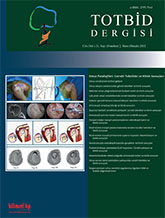
Since the shoulder joint has the widest range of motion in the body, each pathology of the shoulder joint reduces the quality of life by limiting shoulder movements and functions. Rotator cuff muscles consist of the supraspinatus, infraspinatus, subscapularis and teres minor muscles, which are dynamic stabilizers; together with the biceps-labral complex and glenohumeral ligament, known as static stabilizers, they play an important role in the movement and stability of the shoulder joint. Rotator cuff tears are encountered more frequently by orthopedic surgeons as advanced age activities increase and life expectancy increases. Pain is the most common admission cause of the orthopedic surgeon. Magnetic resonance imaging (MRI) is the gold standard for diagnosis of rotator cuff tears. Treatment includes conservative and surgical methods. The fact that the tear does not improve over time despite conservative treatment and symptoms such as pain and loss of range of motion indicate that it is time to discuss surgical treatment options. Arthroscopic repair is the most commonly used method in the surgical treatment of rotator cuff tears in recent years. The clinical results of a well-treated cuff tear will be quite satisfactory.